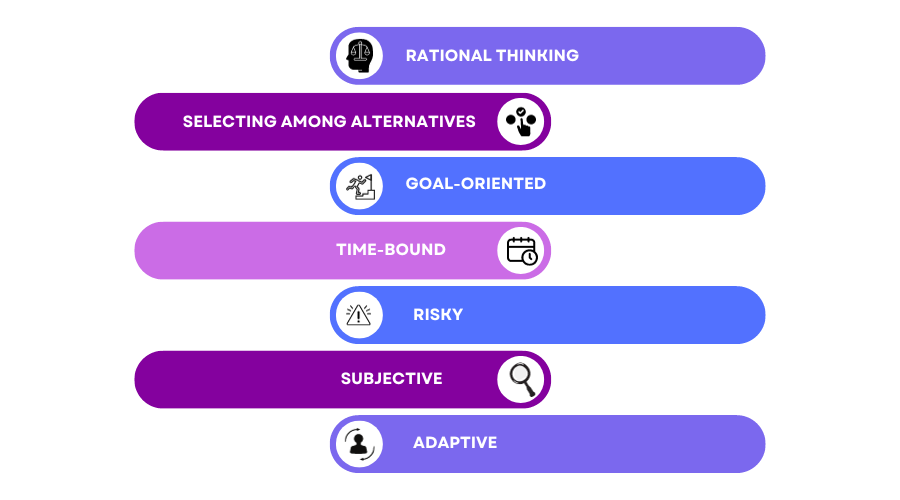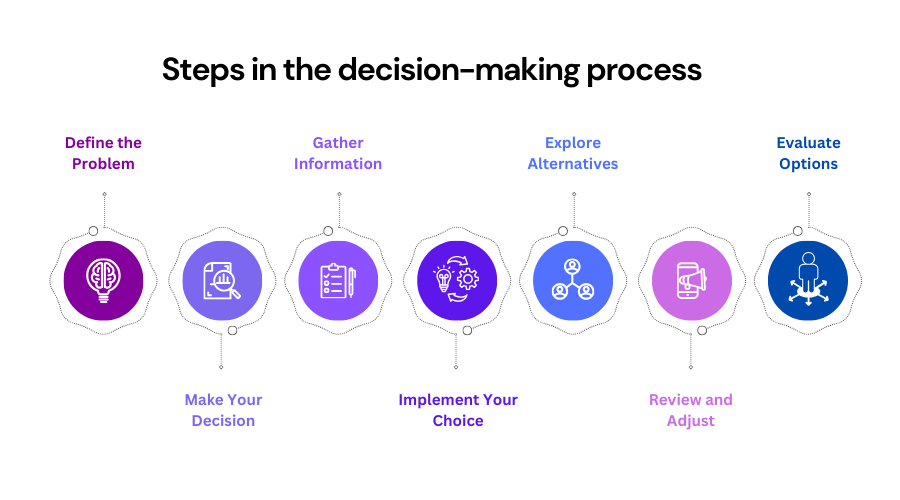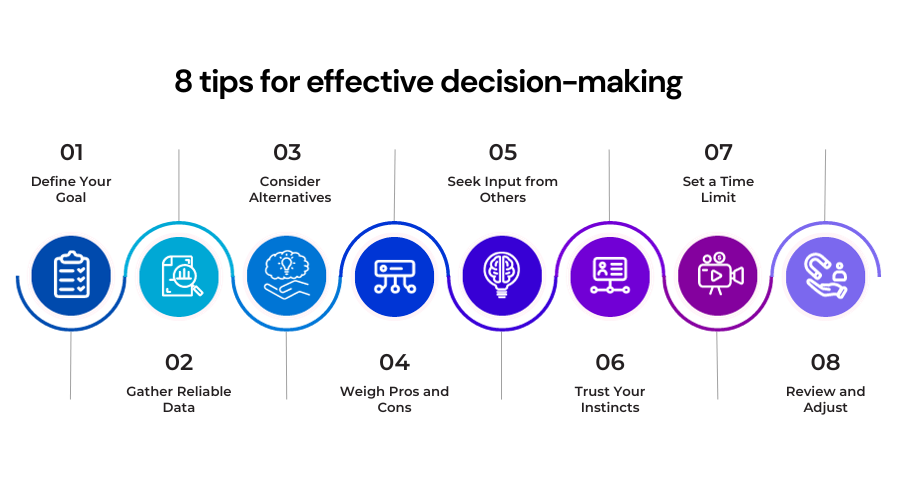
What Is Decision Making?
Decision Making Definition:
Choosing the right and practical course of action from alternatives to achieve the specified result. Decision-making is the core of management.
Decision Making is a management strategy and process for selecting the most sensible solution from a set of alternatives to achieve the best result.
Modern management involves a lot of decision-making. In the demanding environment in which they work, every professional or management makes dozens of judgments.
It’s a crucial step since they must decide on organizational and managerial actions and priorities. Depending on time, resources, and other factors.

Management decisions are crucial because they frequently affect business activities, organizational performance, and corporate objectives.
From a learning standpoint, there has been numerous scientific and practical research.
What Are the Steps of the Decision-Making Process?

1. Choose Your Decision:
To make a choice, you must first identify the problem or question that needs to get addressed. Make your decision as specific as possible.
You’ll throw the decision train off the track before it even leaves the station if you misidentify the problem to solve. Or choose a too broad problem.
2. Obtain Pertinent Information:
Once you’ve decided, it’s time to acquire the facts you’ll need to make that decision. Make an internal assessment to see where your company has succeeded and where it has failed concerning your decision.
Also, look for information from outside sources. Such as studies, market research, and, in some situations, paid consultant assessment.
3. Determine Your Alternatives:
Explore possible solutions to your issue now that you have relevant information at your fingertips. When attempting to achieve a goal, several options get usually considered.
Suppose your firm wants to increase social media engagement, for example. In that case, your options could include paid social ads, a modification in your organic social media method, or a combination of the two.
4. Examine the Evidence:
Once you’ve found many options, weigh the facts in favor of or against them. Examine what other companies have done in the past to achieve success in these areas. And your own company’s achievements and failures.
Determine the probable drawbacks of each option and compare them against the potential benefits.
5. Pick the Best Among the Alternatives:
This stage of the decision-making process is where you put your choice into action. Before reaching this point, you should have clearly defined the decision at hand, collected all the necessary information, and evaluated the various options available. Now, it’s time to move forward and make your decision.
6. Take the Following Steps:
Take action on your decision once you’ve made it! Create a strategy to help you make your decision a reality. Create a project plan for your decision, then allocate responsibilities to your team.
7. Reassess Your Decision:
Look at your decision after a specific timeframe. Have you discovered a solution to the problem? Have you responded to the question? Did you achieve your objectives?
Key Highlights:
- Decision-making is a crucial management strategy and process for selecting the best solution from a set of alternatives to achieve optimal results.
- Steps in decision-making include identifying the problem, gathering relevant information, exploring alternative solutions, weighing the evidence against each option, creating a strategy, and periodically reassessing the decision’s effectiveness.
- Effective decision-making saves time and money, which is crucial for organizational success.
What Are the Types of Decision Making?
Programmed And Non-Programmed Decisions:
The nature of programmed decisions is that they are routine and recurrent. These decisions address issues that often arise in a firm. Such as consumer buying behavior, the approval of various employee leave, purchase decisions, and wage increments.
Non-programmed decisions are unusual and unusual. These are instances in which no guidelines or routine management get established.
For example, we can consider problems originating from a loss of market share or increased rivalry in the corporate environment. This non-programmed category encompasses the vast majority of managerial decisions.
Decisions About Operations and Strategy:
Operational decisions are only a byproduct of the organization’s usual operations. These decisions need not take a long time to make and take less time than other decisions.
Subordinates get a lot of responsibilities. The fundamental decision is whether or not to build harmony in a company and whether or not the management is appropriate.
All current concerns and difficulties get considered in strategic decisions. The primary goal is to improve working conditions, equipment, and the efficient use of existing equipment, among other things.
All of these get included in this category. Top-level management usually makes strategic decisions.
Personal and Organizational Decisions:
Suppose a choice is made collectively with the organizational objective in mind. In that case, it refers to the corporate goal.
Suppose the manager decides their capacity (affecting their life). In that case, it refers to the personal goal.
These decisions may have an impact on the organization’s overall performance. For example, suppose an employee decides to leave the company may impact the company. Personal decision-making authority cannot be transferred and solely depends on the individual.
Individual and Group Decisions:
When a single person makes a choice, you call it an individual decision. Individuals usually make routine judgments within the organization’s policy framework.
A standing committee consists of a group of individuals who make group decisions. In general, significant management decisions get delegated to this group. The primary goal of a group decision is to involve as many people as possible in the decision-making process.
Tactical and Operational Decisions:
Policy choices pertain to the organization’s numerous policy matters. Top management makes these decisions which become a tactical choice.
Operational decisions are all day-to-day decisions that you must make to ensure the organization’s appropriate functioning and operation.
Managers at the middle or lower levels can take these. Calculating the bonuses awarded to each individual, for example, is an operational decision. It gets carried out by middle or lower-level managers.
These were the types of managerial decisions made by the organization’s top, medium, and lower-level management to achieve something coordinated. And accomplish the organization’s purpose quickly and successfully.
Why Is Decision Making Important?
Saves Time and Money:
The important reason the top-level decision is important is to save the organization’s time. Ineffective decision-making wastes a lot of time, but it also saps the motivation of the people involved.
The more time you conserve by making quick selections, the better. And when we’re talking about an organization, time is money. As a result, squandering time is equivalent to squandering money.
Boost Your Productivity:
It will enhance your workforce’s productivity more than once if management excels at decision-making and makes effective decisions.
Employees are more willing, for one thing, since they know where the organization is going. They will work with the guarantee that their efforts will not be in vain.
Second, no time gets wasted because the management team is specific that their actions will properly lead their company.
Making the Most of Your Resources:
When it comes to enormous companies with large pools of resources, management must make the best use. It helps your firm reach its full potential by preventing resources from becoming limited. But it also reduces resource waste.
Top-tier decision-making results from recognizing the need for resources in the proper locations and redirecting them away from places that aren’t required.
Cost-Effectiveness:
Placing your products on the market at a reasonable price influences your company’s long-term success. It affects the direction of your business and the market niche you’re aiming for. Decision making seeks to conclude what ideal product management tools and roadmap software are.
Therefore, there will be a lot if management fails to make the proper judgment and misses the right cost plans even by a small margin.
Recognize Opportunities:
There are opportunities everywhere, but the key is to recognize them so that you can seize them one day. On the other hand, a poor choice allows opportunities to slide through your fingers. It also makes them look non-existing.
For example, if there is a great demand for a product on the market and your firm can deliver it.
Inadequate or delayed decision-making may not be capable of leading your company in that direction and allowing you to focus on it.
Set Achievable Objectives:
Setting attainable short- and long-term goals is sometimes more important than following through. Since no matter how hard you attempt, you won’t be able to achieve your goals if you don’t label them as achievable.
You’ll be squandering your time, money, and resources instead. Thus, while maintaining the vision, strong management and excellent decision-making skills will assist you in analyzing your organization. Also, defining achievable goals.
This will assure that you’re on the right track and that visiting destinations aren’t just dead ends.
Improved Marketing Strategies:
Marketing techniques are what get your company noticed in the first place. Your firm will never reach its fullest potential, no matter how good your products or services are, if you can’t advertise your brand effectively to your consumer base.
Tips for Effective Decision-Making
Effective decision-making is a multifaceted process. Here are some essential tips to guide you through the maze of choices:

Data-Driven Insights:
To make smart choices, start with insights rather than assumptions. Leverage analytics, customer feedback, and market research to spot trends, opportunities and pain points. Data gives you an objective view of what’s really going on compared to just guessing. Make decisions informed by hard facts rather than hunches.
Collaboration is Key:
Few choices impact just one person, so involve stakeholders early. Bring together experts from different teams to share perspectives. Develop options together to ensure any path chosen moves your organization forward as a united front. Communication and collaboration lead to decisions everyone can get behind.
Assess the Risks:
Every choice comes with risks, so evaluate potential downsides upfront. Understand how different outcomes could impact goals, customers or finances. Create contingency plans for risks that may materialize. With informed risk assessment, you can navigate dangers that could torpedo a decision.
Effective decision-making weaves together insights, collaboration and risk awareness. By following these principles, your choices are less likely to be wild guesses and more aligned with reality and organizational priorities. The result is a steady course of actions providing the greatest chances of success.
FAQs
- Provides additional knowledge
- Increase the number of persons who participate
- More options should get provided.
- Increases the level of dedication and acceptance
- Enhances the decision-making process
- Assists in the organization’s strengthening
When you make good decisions, you take actions that benefit you and others in the enterprise.
The 7 C’s of decision making is a framework created by Dr. David R. They are – Communication, Convictions, Common sense, Circumstances, Counsel, Confirmation, and Contentment.
In decision theory, there are four fundamental elements: acts, events, outcomes, and payoffs.
